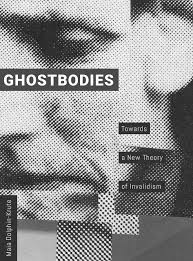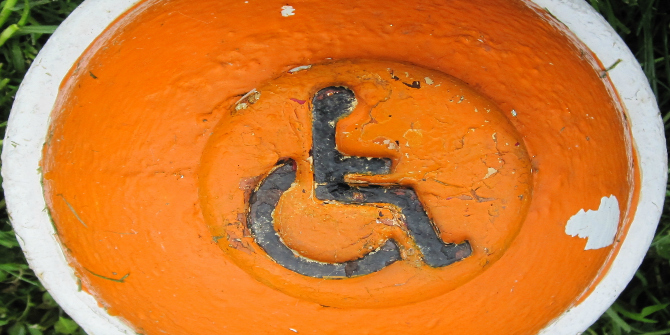In Ghostbodies: Towards a New Theory of Invalidism, Maia Dolphin-Krute explores depictions of chronic illness, proposing the idea of the ‘ghostbody’ as a means of understanding both its representation and potential. While the writing style and lack of concrete examples may at times limit the ability of scholars to transfer its concepts to other disciplines, Matthew Hacke welcomes this book as an exciting and broadly unique contribution to the study of cultural constructions of illness and disability.
Ghostbodies: Towards a New Theory of Invalidism. Maia Dolphin-Krute. Intellect. 2017.
Ghostbodies: Towards a New Theory of Invalidism aims to unpack the chronically ill body in literature, offering ways of understanding its representation as well as its potential. The monograph is influenced by a personal response to the representation of illness almost as much as it is by an analytic standpoint. The author, Maia Dolphin-Krute, has previously published on her own experience with chronic illness as well as further performance-based commentary on opioid use. This dual focus offers an interesting opening, although the text could do more to provide concrete tools and frameworks to make its ideas more transferable to other disciplines and fields.
The titular ‘ghostbody’ is the frame for Dolphin-Krute’s approach to invalidism. As a ghost is a disembodied, uncanny being, a ‘ghostbody’ is a human fundamentally unsettled from its expected physicality and vitality. Dolphin-Krute uses this term in a variety of ways, but for the most part, she finds the frame useful for two main reasons.
Firstly, the concept of the ‘ghostbody’ allows Dolphin-Krute to tackle a serious cognitive dissonance in terms of societal and individual understandings of long-term sickness. The author argues that we can understand notions of health, and conversely overt disability or acute disease, as they are easy to categorise. However, we fail to grasp daily, repetitive chronic illness as the pain and sickness it causes are invariably invisible (22). This results in us forcing an image, or an ‘apparition’, of disease onto the ill person. Well-being in an ill person ‘must only be pretend’ (25), as the sustained presence of the non-infectious, non-quarantined, ill body ‘contaminates’ (19) our view of the sick person and the world around them. Therefore, as we do not let the ill person ‘present themselves as quickly and completely’ (10) but still admit them as human, it makes sense to say the ill person becomes spectral – or a distortion of able-bodiedness rather than its resolute antithesis. Thus the term ‘ghostbody’ is a telling and useful frame.
Perception and the slippage between reality and interpretation are critical to the book’s argument. And, ultimately, our failure to take the ill person as they are has morbid results. To discuss this idea, Dolphin-Krute further illustrates the ill body as a place in which death is always apparently imminent. The text emphasises that society, with its ‘compulsory able-bodiedness’, essentially deprives an ill person of life and health post-diagnosis. The author argues that ‘a close to dead body that is sick but also healthy is the single most threatening thing to health’ (107), and therefore it is continually defined in relation to death. According to the author, we perceive an ill person as ‘the living dead; [albeit] more alive than dead’ (5), and as death becomes a stark inevitability in the ill person, they effectively become their own ‘death mask’ (5). The term ‘ghostbody’ displays its strength here again, offering a glimpse of this curious limbo.
The ‘ghostbody’ is a useful term insofar as it allows Dolphin-Krute to manipulate a common cultural trope and employ a rich trove of versatile gothic terminology to animate her argument. However, the main strength of the text lies in the way Dolphin-Krute’s theory of invalidism understands both cultural representations of the ill person and how an ill person internalises and expresses this acute feeling of ghostliness. This duality wouldn’t be possible without the synthesis of formal theoretical writing and the author’s personal experience. Dolphin-Krute’s biographical interjections, such as the appendix that displays her choice of personal writings and reflections, provide a passionate representation of how cultural perception impacts on the person being watched. Without this – admittedly, at first glance, jarring – personal content, it is unlikely such a counterpoint could be put across. By no means is Ghostbodies a confession: the book does not continually place its own author under the microscope. However, if the formal theory of the text offers a clinical, foundational understanding of relevant cultural frameworks, the personal content gives the text an extra dimension, and requires the reader to think more deeply and more urgently about its argument.
The subversive direction of Ghostbodies does not mean it is entirely unique. With regards to theoretical influence, Ghostbodies seems to follow the experimental writing of critics such as Julia Kristeva or Gilles Deleuze in Difference and Repetition, both in form and in content. Kristeva is particularly significant as her definition of ‘abjection’ clearly influences Dolphin-Krute’s understanding of how the ghostbody is seen by others. I was reminded of Powers of Horror: An Essay on Abjection in form too. Ghostbodies is not a critical text in the sense that it propounds an approach then applies it rigorously to various literary examples. Much like Powers of Horror, textual analysis is rather a relative rarity, and the majority of works discussed are not signalled formally in chapter headings or the contents page. Instead, both works are written to be treatises as Ghostbodies meditates on its ideas rather than using them in a more methodical way.
This does cause some problems in Dolphin-Krute’s work. For one, like Kristeva, the text is not the most accessible critical read. I would say the book has strong poststructuralist foundations, and as with Jacques Derrida or Kristeva, a particular, sometimes opaque, writing style follows. As such, Ghostbodies heavily relies on linguistic play to make its arguments, i.e. recursive language, self-conscious ambivalence and slippage between terms and forms. As a result it is often a disorientating read: many readers could spend more time trying to work out what Dolphin-Krute actually means rather than applying the ideas. The author, for example, notes in the conclusion that the book ‘is not just, though it may seem like here, a textual exercise in writing critical theory’, instead deeming it an experiment in writing a ‘sick body of text’ (108) through using words and phrases repetitively in different contexts to mimic the ill person continuously representing themselves incompletely. This is an interesting thought, but it is difficult to see how this idea could be easily pinned down and applied or where students of the field could go from such a tantalising but obscure conclusion. This leads me to think that clearer language or more precise textual examples might offer further openings for future work.
It is evident that Ghostbodies attempts to differentiate itself from previous writing on illness and disability. To a great extent it succeeds in this. The author notes that ‘sociological writing and popular autobiography about chronic illness sets up a normalcy of grieving and coping. Chronic illness is supposed to be only an immense negative force’ (79). The book’s dissection of the uncanny diseased body interrogates this excellently, although an alternative is left not entirely clear. In conclusion, Ghostbodies puts forward some exciting ideas, and is a broadly unique contribution to its field. However, a clearer tone in crucial passages and more robust examples may be needed to make it completely accessible for scholars and students.
Note: This review gives the views of the author, and not the position of the LSE Review of Books blog, or of the London School of Economics.
Image Credit: (Jo Naylor CC BY 2.0).


 Find this book:
Find this book: 




